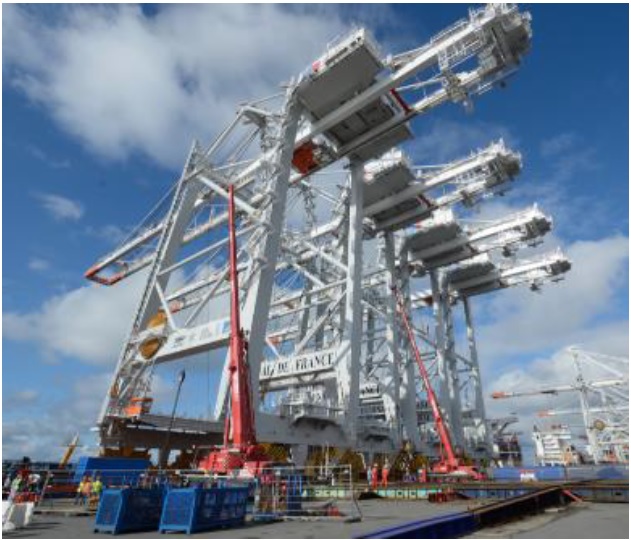- ENGIE awarded the Grand Canal project launched by HAROPA PORT on the Gran Canal du Havre for the development of the Salamandre and France KerEAUzen project
- Development of the Salamandre renewable and low-carbon gas production plant in Le Havre, with CMA CGM
- Launch of a feasibility study for France KerEAUzen, an e-kerosene production unit for which Air France-KLM would be the main customer
As part of the “Grand Canal du Havre” call for projects, through the conclusion of state titles, HAROPA PORT has awarded ENGIE 24 ha of land for the development of a benchmark platform for alternative new industrial fuels embodied by the Salamandre and France KerEAUzen projects. This award is an essential step in the development of these projects and the low-carbon transition of the industrial port zone (ZIP).
ENGIE and its partner CMA CGM also confirmed the development of the Salamandre plant in Le Havre, the world’s first renewable gas production unit based on pyrogasification and methanation technologies for sea transport.
To meet the needs of the airline industry, ENGIE is to launch the feasibility study for France KerEAUzen, a synthetic fuel production unit based on a combination of renewable hydrogen and CO2 supplied by Salamandre and other local industries.
These are two major industrial projects, whose unique complementarity will contribute to the energy transition in France and decarbonization of heavy mobility in Europe.
These projects are fully in line with ENGIE’s development strategy and address a number of challenges:
- Re-industrialising the region through emblematic projects that create new industrial sectors of the future
- Helping to achieve decarbonization targets in hard-to-abate sectors such as sea and air transport.
- Contributing to French energy sovereignty goals
- Sustainability of the energy transition, based on existing infrastructures, networks, means of transport (ships and aircraft), ports and airports
Salamandre, local and renewable energy production to decarbonise sea transport
Salamandre is supported by a first-rate partnership committed to the energy transition, comprising
ENGIE (majority shareholder) and CMA CGM. Discussions have also begun with the Banque des
Territoires to examine ways of providing investment support for the Salamandre project.
This project aims to produce 11,000 metric tons a year of renewable low-carbon gas from dry
biomass from local wood-waste and solid recovered fuel (SRF), to be used in the form of liquefied
natural gas (LNG) by the CMA CGM fleet. This production is equivalent to the average annual
consumption of 10,000 households. This will abate 60,000 metric tons of CO2 emissions a year,
compared with the use of fossil natural gas.
This plant represents:
- The culmination of 10 years of Research & Development carried out by ENGIE1 as part of the GAYA project
- The first concrete result of the strategic partnership signed between ENGIE and CMA CGM in November 2021 to produce 200,000 metric tons a year of renewable gas worldwide by 2028.
- The starting point of a new industrial sector for low-carbon gas and local waste recovery, set to expand rapidly
- Salamandre is expected to be operational in 2027. Thanks to its replicability potential, the validation of this technology on a commercial scale will mobilize the investments needed to bring the pyrogasification and methanation markets to a first significant stage by 2030 across Europe.
France KerEAUzen, a world-class platform for synthetic fuels
The France KerEAUzen project aims to develop an e-kerosene production unit (an ultra-lowcarbon synthetic fuels, JET A-1 SAF) with a capacity of approximately 70,000 metric tons a year,
by combining recycled local CO2 and renewable hydrogen. As from 2028, this innovative unit, a
pioneer in the market for sustainable aviation fuel, should also provide strategic solutions for hardto-abate industrial sectors in the area. This unit will combine production of renewable hydrogen, to meet the needs of industry in the ZIP and heavy-duty transport, alongside production of feedstock for green chemistry, such as naphtha.
Every year, 270,000 metric tons of CO2 from Salamandre and local industry will be recycled in the electrified syngas production reactor. At the same time, renewable hydrogen will be produced using an electrolyser of approximately 250 MW.
France KerEAUzen is a major vector in the energy transition, and aims to supply the Roissy Charles de Gaule and Orly airport hubs via pipelines, thus meeting French and European obligations.The Air France-KLM Group is the main operator from these hubs, and is a partner in this project, which is one of the answers to the need to develop a sustainable aviation fuel production sector in France. Preliminary discussions have also just begun with the Banque des Territoires concerning this project.







